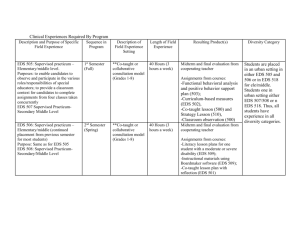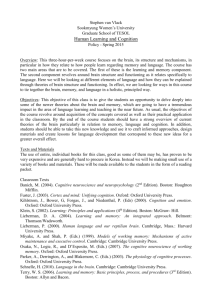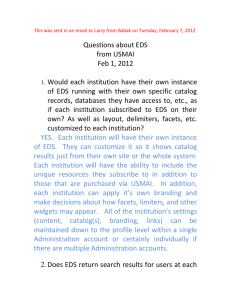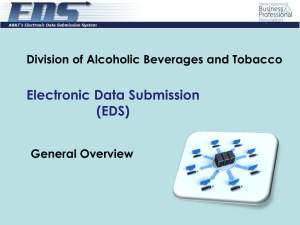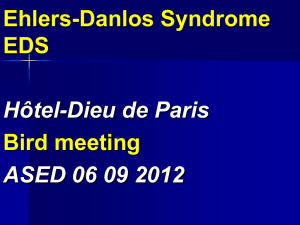Gender, Sexuality, and Language - TESOL International Research
advertisement
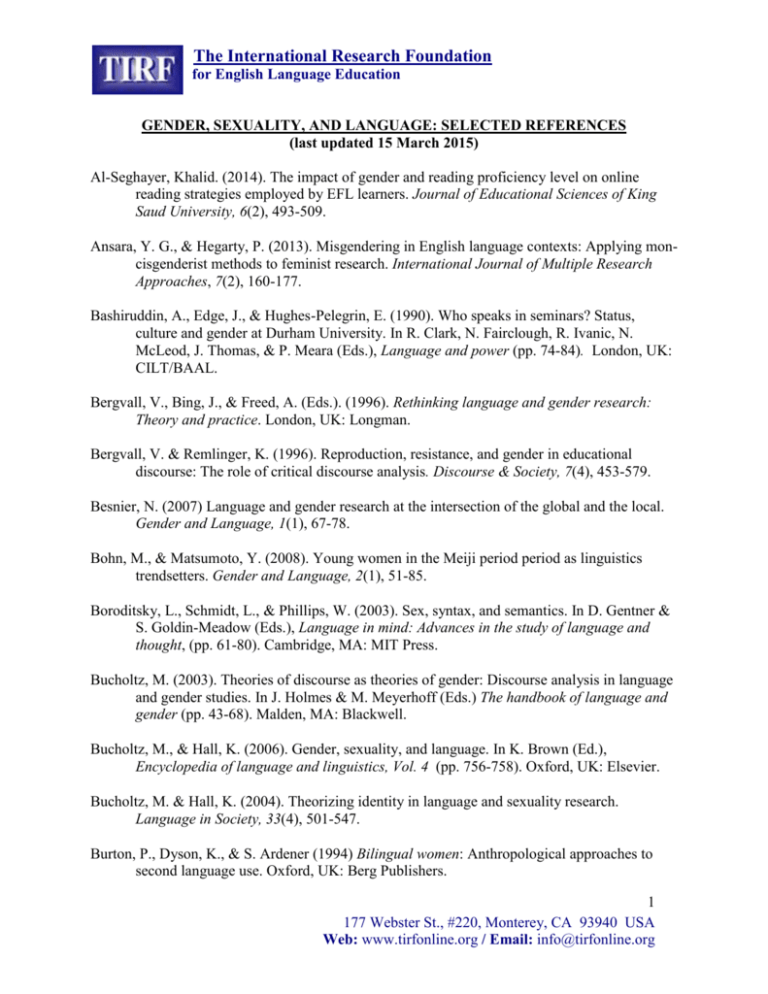
The International Research Foundation for English Language Education GENDER, SEXUALITY, AND LANGUAGE: SELECTED REFERENCES (last updated 15 March 2015) Al-Seghayer, Khalid. (2014). The impact of gender and reading proficiency level on online reading strategies employed by EFL learners. Journal of Educational Sciences of King Saud University, 6(2), 493-509. Ansara, Y. G., & Hegarty, P. (2013). Misgendering in English language contexts: Applying moncisgenderist methods to feminist research. International Journal of Multiple Research Approaches, 7(2), 160-177. Bashiruddin, A., Edge, J., & Hughes-Pelegrin, E. (1990). Who speaks in seminars? Status, culture and gender at Durham University. In R. Clark, N. Fairclough, R. Ivanic, N. McLeod, J. Thomas, & P. Meara (Eds.), Language and power (pp. 74-84). London, UK: CILT/BAAL. Bergvall, V., Bing, J., & Freed, A. (Eds.). (1996). Rethinking language and gender research: Theory and practice. London, UK: Longman. Bergvall, V. & Remlinger, K. (1996). Reproduction, resistance, and gender in educational discourse: The role of critical discourse analysis. Discourse & Society, 7(4), 453-579. Besnier, N. (2007) Language and gender research at the intersection of the global and the local. Gender and Language, 1(1), 67-78. Bohn, M., & Matsumoto, Y. (2008). Young women in the Meiji period period as linguistics trendsetters. Gender and Language, 2(1), 51-85. Boroditsky, L., Schmidt, L., & Phillips, W. (2003). Sex, syntax, and semantics. In D. Gentner & S. Goldin-Meadow (Eds.), Language in mind: Advances in the study of language and thought, (pp. 61-80). Cambridge, MA: MIT Press. Bucholtz, M. (2003). Theories of discourse as theories of gender: Discourse analysis in language and gender studies. In J. Holmes & M. Meyerhoff (Eds.) The handbook of language and gender (pp. 43-68). Malden, MA: Blackwell. Bucholtz, M., & Hall, K. (2006). Gender, sexuality, and language. In K. Brown (Ed.), Encyclopedia of language and linguistics, Vol. 4 (pp. 756-758). Oxford, UK: Elsevier. Bucholtz, M. & Hall, K. (2004). Theorizing identity in language and sexuality research. Language in Society, 33(4), 501-547. Burton, P., Dyson, K., & S. Ardener (1994) Bilingual women: Anthropological approaches to second language use. Oxford, UK: Berg Publishers. 1 177 Webster St., #220, Monterey, CA 93940 USA Web: www.tirfonline.org / Email: info@tirfonline.org The International Research Foundation for English Language Education Butler, J. (1990). Gender trouble: Feminism and the subversion of identity. New York, NY: Routledge. Cameron, D. (1985) Feminism and linguistic theory. London, UK: Macmillan. Cameron, D. (1997). Performing gender identity: Young men’s talk and the construction of heterosexual masculinity. In S. Johnson & U. Meinhof (Eds.), Language and masculinity (pp. 47-64). Oxford, UK: Blackwell Publishers. Cameron, D. (2005). Language, gender, and sexuality: Current issues and new directions. Applied Linguistics, 26, 482-502. Cameron, D. (2010). Sex/gender language and the mew biologism. Applied Linguistics, 31(2), 173-192. Cameron, D., & Kulick, D. (Eds.). (2006). The language and sexuality reader. London, UK and New York, NY: Routledge. Cameron, D. & Kulick, D. (2003). Language and sexuality. Cambridge, UK: Cambridge University Press. Coates, J. (1997). Language and gender: A reader. Oxford, UK: Blackwell. Costas, C., Kantsa V., & Yannakopoulos K. (2010). Language and sexuality (through and) beyond gender., Newcastle-upon-Tyne, UK: Cambridge Scholars Publishing. Crawford, M. (1995). Talking difference: On gender and language. Sage Publications. Thousand Oaks, CA: Sage. Croll, P. (1985). Teacher interaction with individual male and female pupils in junior age classrooms. Educational Research, 27(3), 220-223. Cummings, M. (2009). Someday this pain will be useful to you: Self-disclosure and lesbian and gay identity in the ESL writing classroom. Journal of Basic Writing, 28(1), 71-89. De Beauvoir, S. (2011). The second sex. 1949. (Trans. C. Borde & S. Malovany-Chevallier). London, UK: Vintage. Dumas, J. (2010). Sexual identity and the LINC Classroom. Canadian Modern Language Review, 66(4), 607-627. Eckert, P., & McConnell-Ginet, S. (1992). Think practically and look locally: Language and gender as community-based practice. Annual Review of Anthropology, 21, 461-490. 2 177 Webster St., #220, Monterey, CA 93940 USA Web: www.tirfonline.org / Email: info@tirfonline.org The International Research Foundation for English Language Education Eckert, P., & McConnell-Ginet, S. (2003). Language and gender. New York, NY: Cambridge University Press. Edelman, E., & Zimman, L. (2014). Boycunts and bonus holes: Discourses about transmasculine bodies and the sexual productivity of genitals. Journal of Homosexuality, 61(5), 673-690. Edley, N., & Wetherell, M. (1997). Jockeying for position: The construction of masculine identities. Discourse & society, 8(2), 203-217. Ehrlich, S. (1997) Gender as social practice: Implications for second language acquisition. Studies in Second Language Acquisition, 19(4), 421-446. Endo, O. (1991). Issues and challenges facing female teachers of JSL. The Language Teacher, 15(7), 7-10. Everett, C. (2011). Gender, pronouns and thought. Gender and Language, 5(1), 133-152. Everett, C. (2008). Evidence for language-mediated thought in the perception of non-gendered figures. Texas Linguistic Forum, 52, 24-33. Freed, A. (1992). We understand perfectly: A critique of Tannen's view of cross-sex communication. In K. Hall, M. Bucholtz, & B. Moonwomon (Eds.) Locating power: Proceedings of the second Berkeley Women and Language Conference (Vol. 1, pp. 144152.). Berkeley, CA: Berkeley Women and Language Group. Gal, S. (1978). Peasant men can't get wives: Language and sex roles in a bilingual community. Language in Society, 7 (1), 1-17. Goldstein, T. (2001). Researching women’s language practices in multilingual work- places. In A. Pavlenko, A. Blackledge, I. Piller and M. Teutsch-Dwyer (Eds.) Multilingualism, second language learning, and gender (pp. 79 -98). Berlin: Mouton de Gruyter. Gordon, D. (2004). “I’m tired. You clean and cook”: Shifting gender identities and second language socialization. TESOL Quarterly, 38(3), 437-457. Hall, K., & Bucholtz, M. (Eds.). (1995). Gender articulated: Language and the socially constructed self. New York, NY: Routledge. Harbeck, K. M. (Ed.). (1991). Coming out of the classroom closet: Gay and lesbian students, teachers and curricula. Binghamton, NY: Harrington Park Press. 3 177 Webster St., #220, Monterey, CA 93940 USA Web: www.tirfonline.org / Email: info@tirfonline.org The International Research Foundation for English Language Education Higgins, C. (2010) Gender identities in language education. In S. McKay & N. Hornberger (Eds.), Sociolinguistics and Language Education (pp. 370-397). Bristol: Multilingual Matters. Holmes, J. (2006). Gendered talk at work. Oxford, UK: Blackwell Publishers. Holmes, J., & Meyerhoff, M. (Eds.). (2003). The handbook of language and gender. Oxford, UK: Blackwell. Horne, S. G., Ovrebo, E., Levitt, H. M., & Franeta, S. (2009). Leaving the herd: The lingering threat of difference for same-sex desires in postcommunist Russia. Sexuality Research & Social Policy, 6(2), 88-102. Hruska, B. (2004). Constructing gender in an English dominant kindergarten: Implications for second language learners. TESOL Quarterly , 38, 459-484. Ide, S. (1982). Japanese sociolinguistics: Politeness and women’s language. Lingua, 57(2), 357385. Inoue, M. (1994). Gender and linguistic modernization: Historicizing Japanese women’s language. In M. Bucholtz, A.C. Liang, L.A. Sutton, & C. Hines (Eds.), Cultural performances: Proceedings of the third Berkeley women and language conference (pp. 322-333). Berkeley, CA: Berkeley Women and Language Group. Inoue, M. (2006). Vicarious language: Gender and linguistic modernity in Japan. Berkeley, CA: University of California Press. Johnson, S., & Meinhof, U. (Eds.). (1997). Language and masculinity. Oxford : Blackwell. Julé, A. (2004). Speaking in silence: A case study of a Punjabi girl. In B. Norton & A. Pavlenko (Eds.), Gender and English language learners (pp. 69-80). Arlington, VA: TESOL. Kelsky, K. (2001). Women on the verge: Japanese women, western dreams. Durham and London, UK: Duke University Press. Kissau, S., & Wierzalis, E. (2008). Gender identity and homophobia: The impact on adolescent males studying French. Modern Language Journal, 92(3), 402-413. Kendall, S., & Tannen, D. (1997). Gender and language in the workplace. In R. Wodak (Ed.), Gender and discourse (pp. 81-105). Thousand Oaks, CA: Sage Publications. Kiesling, S. F. (2009). Fraternity men: Variation and discourses of masculinity. In N. Coupland & A. Jaworski (Eds.), The new sociolinguistic reader (pp. 187-200). Basingstoke, UK: Palgrave Macmillan. 4 177 Webster St., #220, Monterey, CA 93940 USA Web: www.tirfonline.org / Email: info@tirfonline.org The International Research Foundation for English Language Education Kitzinger, C. 2005. Speaking as a heterosexual: (How) does sexuality matter for talk-ininteraction, Research on Language and Social Interaction, 38(3), 221-265. Kitzinger, C. (2007). Is 'woman' always relevantly gendered? Gender and Language, 1(1), 3940. Kobayashi, Y. (2007). Japanese working women and English study abroad. World Englishes, 26 (1), 62-71. Kubota, R. (2003). New approaches to gender, class, and race in second language writing. Journal of Second Language Writing, 12(1), 31-47. Kulick, D. (1998). Anger, gender, language shift, and the politics of revelation in a Papua New Guinean village. In B. B. Schieffelin, K. A. Woolard, & P. V. Kroskrity (Eds.), Language ideologies: Practice and theory (pp. 87-102). New York, NY: Oxford University Press. Kumashiro, K. (2002). Troubling education: Queer activism an anti-oppressive pedagogy. New York, NY: Routledge Falmer. Lakoff, R. (1975). Language and woman’s place. New York, NY: Harper and Row. Lin, A., Grant, R., Kubota, R., Motha, S., Sachs, G. T., Vandrick, S., & Wong, S. (2004). Women faculty of color in TESOL: Theorizing our lived experiences. TESOL Quarterly, 38(3), 487-504. Livia, A., & Hall, K. (Eds.). (1997). Queerly phrased: Language, gender, and sexuality. New York, NY: Oxford University Press. Makoni, S., & Makoni, B. (2011). The discursive construction of the female body in family planning pamphlets. In V. Ramanathan & P. McPherron (Eds.), Language, bodies, and health (pp. 193-221). New York, NY: De Gruyter Mouton. Martinez-Roldan, C. (2005). Examining bilingual children's gender ideologies through critical discourse analysis. Critical Inquiry in Language Studies, 2(3), 157 – 178. Matsumoto, Y. (1996). Does less feminine speech in Japanese mean less femininity? In N. Warner, J. Ahlers, L. Bilmes, M. Oliver, S. Wertheim, & M. Chen (Eds.), Gender and belief systems: Proceedings of the fourth Berkeley women and language conference (pp. 455-467). Berkeley, CA: Berkeley Women and Language Group. Matsumoto, Y. (2002). Gender identity and the presentation of self in Japanese language and culture in teaching Japanese as a foreign language. Japanese Language and Literature, 37, 27-48. 5 177 Webster St., #220, Monterey, CA 93940 USA Web: www.tirfonline.org / Email: info@tirfonline.org The International Research Foundation for English Language Education McElhinny, B. (2003). Theorizing gender in sociolinguistics and linguistic anthropology. In J. Holmes & M. Meyerhoff (Eds.), The handbook of language and gender (pp. 21-42). Oxford, UK: Blackwell. McElhinny, B. (Ed.) (2007). Words, worlds and material girls: Language, gender, globalization. Berlin: Mouton de Gruyter. McConnell-Ginet, S. (2011). Gender, sexuality, and meaning: Linguistic practice and politics. Oxford, UK: Oxford University Press. McGloin, N. (1990). Sex difference and sentence-final particles. In S. Ide, & N. McGloin (Eds.), Aspects of Japanese women’s language (pp. 23-41). Tokyo, Japan: Kuroshio Shuppan. McMahill, C. (2001). Self-expression, gender, and community: A Japanese feminist English class. In A. Pavlenko, A. Blackledge, I. Piller, & M. Teutsch-Dwyer (Eds.) Multilingualism, second language learning, and gender (pp. 307-244). Berlin, Germany: Mouton. Meece, J.L. Glienke, B.B. & Burg, S. (2006). Gender and motivation. Journal of School Psychology, 44, 351-373. doi:10.1016/j.jsp.2006.04.004 Menard-Warwick, J. (2004). “I always had the desire to progress a little”: Gendered narratives of immigrant language learners. Journal of Language, Identity, and Education, 3(4), 295311. Menard-Warwick, J. (2006). “The thing about work”: Gendered narratives of a transnational, trilingual Mexicano. International Journal of Bilingual Education and Bilingualism, 9(3), 359-415. Miller, L. (2004). Those naughty teenage girls: Japanese Kogals, slang, and media assessments. Journal of Linguistic Anthropology, 14(2), 225-247. Moje, E., & MuQaribu, M. (2003). Literacy and sexual identity. Journal of Adolescent & Adult Literacy, 47(3), 204-208. Murphy, B. (2010). Corpus and sociolinguistics: Investigating age and gender in female talk. Amsterdam, The Netherlands: John Benjamins. Nakamura, M. (2003). Discourse construction of the ideology of women’s language: Women’s disciplinary book/moral textbooks and the unification of written and spoken language in the Meiji/Taisho periods (1868-1926). Nature-People-Society, 35, 1-39. Kanagawa, Japan: Kanto Gakuin University. Nelson, C. (1999). Sexual identities in ESL: Queer theory and classroom inquiry. TESOL Quarterly, 33(3), 371-391. 6 177 Webster St., #220, Monterey, CA 93940 USA Web: www.tirfonline.org / Email: info@tirfonline.org The International Research Foundation for English Language Education Nelson, C. D. (2004). Beyond straight grammar: Using lesbian/gay themes to explore cultural meanings. In B. Norton & A. Pavlenko (Eds.) Gender and English language learners (pp. 15-28). Alexandria, VA: TESOL. Nelson, C. D. (2009). Sexual identities in English language education: Classroom conversations. New York, NY: Routledge. Norton, B. (2000). Identity and language learning: Gender, ethnicity and educational change. London, UK: Longman. Norton, B., & Pavlenko, A. (Eds.) .(2004). Gender and English language learners. Alexandria, VA: TESOL. Norton, B., & Pavlenko, A. (2004) Addressing gender in the ESL/EFL classroom. TESOL Quarterly, 38(3), 504-514. O’Barr, W., & Atkins, B. K. (1980). “Women’s language” or “powerless language”?. In S. McConnell-Ginet, R. Borker, & N. Furman (Eds.), Women and language in literature and society (pp. 93-110). New York, NY: Praeger/Greenwood Publishing Group. Ochs, E. (1992). Indexing gender. Rethinking context: Language as an Interactive Phenomenon, 11(11), 335. Ochs, E. (1992). Indexing gender. In A. Duranti & C. Goodwin (Eds.), Rethinking context: Language as an interactive phenomenon (pp. 335-358). Cambridge, UK: Cambridge University Press. Ochs, E. (1993). Indexing gender. In B.D. Miller (Ed.), Sex and gender hierarchies (pp. 146169). Cambridge, MA: Cambridge University Press. Ohara, Y., Saft, S., & Crookes, G. (2001). Toward a feminist critical pedagogy in a beginning Japanese-as-foreign-language class. Japanese Language and Literature, 35, 105-133. Okamoto, S. (1994). “Gendered” speech styles and social identity. In M. Bucholtz, A.C. Liang, L.A. Sutton, & C. Hines (Eds.), Cultural performances: Proceedings of the third Berkeley women and language conference (pp. 569-581). Berkeley, CA: Berkeley Women and Language Group. Okamoto, S. (2008). Rethinking ‘norms’ for Japanese women’s speech. In S. Sato & N.M. Doerr (Eds.), Rethinking language and culture in Japanese education: Beyond the standard (pp. 82-105). Bristol, UK: Multilingual Matters. Okamoto, S., & Sato, S. (1992). Less feminine speech among young Japanese females. In K. Hall, M. Bucholtz, & B. Moonwomon (Eds.), Locating power: Proceedings of the seond 7 177 Webster St., #220, Monterey, CA 93940 USA Web: www.tirfonline.org / Email: info@tirfonline.org The International Research Foundation for English Language Education Berkeley women and language conference (pp. 478-488). Berkeley, CA: Berkeley Women and language Group. Okamoto, S., and Smith, J. S. (Eds.). 2004. Japanese language, gender, and ideology: Cultural models and real people. Oxford, UK: Oxford University Press. Pavlenko, A. (2001). Language learning memoirs as a gendered genre. Applied Linguistics, 2(2), 213-240. Pavlenko, A. (2001). Bilingualism, gender, and ideology. International Journal of Bilingualism, 5(2), 117-151. Pavlenko, A. (2001). "How am I to become a woman in an American vein?": Negotiation of gender in second language learning. In A. Pavlenko, A. Blackledge, I. Piller, & M. Teutsch-Dwyer (Eds.), Multilingualism, second language learning, and gender (pp. 133174). Berlin, Germany: Mouton de Gruyter. Pavlenko, A. (2002) Socioeconomic conditions and discursive construction of women’s identities in post-Soviet countries. In M. Kelemen & M. Kostera (Eds.), Critical management research in Eastern Europe: Managing the transition (pp. 83-110). London, UK: Palgrave/McMillan. Pavlenko, A. (2004). Gender and sexuality in foreign and second language education: Critical and feminist approaches. In B. Norton & K. Toohey (Eds.), Critical pedagogies and language learning (pp. 53-71). Cambridge, UK: Cambridge University Press. Pavlenko, A. (2005). "Ask each pupil about her methods of cleaning": Ideologies of language and gender in Americanization instruction. International Journal of Bilingual Education and Bilingualism, 8(4), 275-297. Pavlenko, A. , Blackledge, A., Piller, I., & M. Teutsch-Dwyer (Eds.) (2001) . Multilingualism, second language learning, and gender. Berlin/New York, NY: Mouton de Gruyter. Pavlenko, A., & Piller, I. (2007). Language education and gender. In S. May (Ed.) Encyclopedia of language and education (pp. 57-69). Volume 1. Berlin, Germany: Springer. Piller, I. (2002). Bilingual couples talk: The discursive construction of hybridity. Amsterdam, The Netherlands: John Benjamins. Piller, I., & Pavlenko, A. (2004). Bilingualism and gender. In T. Bhatia & W. Ritchie (Eds.) Handbook of bilingualism. (pp. 489-511). Oxford, UK: Blackwell. Piller, I., & Pavlenko, A. (2007). Globalization, gender, and multilingualism. In L. Volkmann & H. Decke-Cornill (Eds.), Gender studies and foreign language teaching (pp. 15-30). Tübingen, Germany: Narr. 8 177 Webster St., #220, Monterey, CA 93940 USA Web: www.tirfonline.org / Email: info@tirfonline.org The International Research Foundation for English Language Education Piller, I. & Pavlenko, A. (2009). Globalization, Multilingualism, and Gender: Looking into the Future (p. 10). In V. Cook & L. Wei (Eds.) Contemporary applied linguistics. Volume 2. Linguistics for the real world. London, UK: Continuum. Piller, I., & K. Takahashi (2010). At the intersection of gender, language, and transnationalism. In N. Coupland (Ed.) The handbook of language and globalization. (pp. 540-553). Malden, MA: Wiley Blackwell. Preece, S. (2008). Multilingual gendered identities: Female undergraduate students in London talk about heritage languages. Journal of Language, Identity, and Education, 7, 41–60. Prewitt-Freilino, J. L., Caswell, T. A., & Laakso, E. K. (2012). The gendering of language: A comparison of gender equality in countries with gendered, natural gender, and genderless languages.” Sex Roles, 66, 268-281. Rey, J. (2001). Changing gender roles in popular culture: Dialogue in Star Trek episodes from 1966 to 1993. In S. Conrad & D. Biber (Eds.), Variation in English: Multi-dimensional studies (pp. 138-156). London: Longman. Saft, S., & Ohara, Y. (2004). Promoting critical reflection about gender in EFL classes at a Japanese university. In B. Norton & A. Pavlenko (Eds.) Gender and English language learners (pp. 143-154). Alexandria, VA: TESOL. Satake, K. (2003). Terebi anime no rufusuru “onna kotoba/otoko kotoba” kihan [A norm of “women’s language/men’s language spread by television animations]. Kotoba [Language], 24, 64-74. Shibamoto, S. J. (1985). Japanese women’s language. Orlando, FL: Academic Press, Inc. Siegal, M., & Okamoto, S. (2003). Toward reconceptualizing the teaching and learning of gendered speech styles in Japanese as a foreign language. Japanese Language and Literature, 37(1), 49-66. Simon-Maeda, A. (2004). Transforming emerging feminist identities: A course on gender and language issues. In B. Norton & A. Pavlenko (Eds.) Gender and English language learners (pp. 127-143). Alexandria, VA: TESOL. Skapoulli, E. (2004). Gender codes at odds and the linguistic construction of hybridity. Journal of Language, Identity and Education, 3(4), 245-260. Skilton-Sylvester, E. (2002). Should I stay or should I go? Investigating Cambodian women’s participation and investment in adult ESL programs. Adult Education Quarterly, 53(1), 926. 9 177 Webster St., #220, Monterey, CA 93940 USA Web: www.tirfonline.org / Email: info@tirfonline.org The International Research Foundation for English Language Education Smith, S. J. (1992). Women in charge: Politeness and directives in the speech of Japanese women. Language in Society, 21(1), 59-82. Spender, D. (1980). Man made language. New York, NY: Routledge. Sunderland, J. (2004). Classroom interaction, gender, and foreign language learning. In B. Norton & K. Toohey (Eds.), Critical pedgagogies and language learning (pp. 222-241). Cambridge, UK: Cambridge University Press. Sunderland, J., Crowley, M, Abdul Rahim, F., Leontzakou, C., & Shattuck, J. (2001). From bias ‘in the text’ to ‘teacher talk around the text’: An exploration of teacher discourse and gendered foreign language textbook texts. Linguistics and Education, 11(3), 251-286. Swann, J. (1998). Talk control: An illustration from the classroom of problems in analysing male dominance of conversation. In J. Coates (Ed.) Language and Gender (pp. 185-196). Oxford, UK: Blackwell. Talbott, M. (1992). The construction of gender in a teenage magazine. In N. Fairclough (Ed.), Critical language awareness (pp. 175-199). London, UK: Addison Wesley Longman. Tannen, D. (1990). You just don’t understand. New York, NY: Morrow. Tannen, D. (1994). Gender and discourse. Oxford, UK: Oxford University Press. Tannen, D. (1994). Talking from 9 to 5: How women’s and men’s conversational styles affect who gets heard, who gets credit, and what gets done at work. New York, NY: W. Morrow. Tannen, D. (1995). Talking from 9 to 5: Women and men in the workplace: Language, sex, and power. New York, NY: Avon Books. Takahashi, K. (2012) Multilingualism and gender. In M. Martin-Jones, A. Blackledge, & A. Creese (Eds.). The Routledge handbook of multilingualism (pp. 419-435). New York, NY: Routledge. Takahashi, K. (2013). Language learning, gender and desire: Japanese women on the move. (Vol. 16). Bristol, UK: Multilingual Matters. Takasaki, M. (2002). “Onna kotoba” o tsukurikaeru josei no tayoo na gengo koodoo [Women’s various verbal behaviors that reconstruct “women’s language”]. Gengo [Language], 31(2), 40-47. Tannen, D. (1995). Talking from 9 to 5: Women and men in the workplace: Language, sex, and power. New York, NY: Avon Books. 10 177 Webster St., #220, Monterey, CA 93940 USA Web: www.tirfonline.org / Email: info@tirfonline.org The International Research Foundation for English Language Education Vandrick, S. (1997). The role of hidden identities in the postsecondary ESL classroom. TESOL Quarterly, 31(1), 153-157. Vandrick, S. (2000). Language, culture, class, gender, and class participation. Retrieved from http://files.eric.ed.gov/fulltext/ED473086.pdf Vandrick, S. (2009). Interrogating privilege: Reflections of a second language educator. Ann Arbor, MI: University of Michigan Press. Vandrick, S. (2013). Promoting gender equity in the postsecondary ESL class (pp. 73-88). In T. Smoke (Ed.). (2013). Adult ESL: Politics, pedagogy, and participation in classroom and community programs. New York, NY: Routledge. Wadell, E., Frei, K., & Martin, S. (2012). Professional development through inquiry: Addressing sexual identity in TESOL. CATESOL Journal, 23(1), 99-109. Waksler, R. (1995). She’s a mensch and he’s a bitch: neutralizing gender in the 90s. English Today, 11, 3-6. West, C., & Zimmerman, D. (1987). Doing gender. Gender in Society, 1, 125-151. Wetherell, M., & Edley, N. (2009). Masculinity manoeuvres: Critical discursive psychology and the analysis of identity strategies. In N. Coupland & A. Jaworski (Eds.), The new sociolinguistic reader (pp. 201-214). Basingstoke, UK: Palgrave Macmillan. Woolard, K. A. (1997). Between friends: Gender, peer group structure, and bilingualism in urban Catalonia. Language in Society, 26, 533-560. Zimman, L., (2009). ‘The other kind of coming out’: Transgender people and the coming out narrative genre. Gender & Language, 3(1), 53-80. Zimman, L. (2010). Female-to-male transsexuals and gay-sounding voices: A pilot study. Colorado Research in Linguistics 22(1). http://www.colorado.edu/ling/CRIL/Volume22_Issue1/. Zimman, L. (2013). Hegemonic masculinity and the variability of gay-sounding speech: The perceived sexuality of transgender men. Journal of Language & Sexuality, 2(1), 5-43. Zimman, L. (2014). The discursive construction of sex: Remaking and reclaiming the gendered body in talk about genitals among trans men. In L. Zimman, J. Raclaw, & J. Davis (Eds.), Queer excursions: Retheorizing binaries in language, gender, and sexuality (pp. 13-34). Oxford, UK: Oxford University Press. (pp. 13-34). 11 177 Webster St., #220, Monterey, CA 93940 USA Web: www.tirfonline.org / Email: info@tirfonline.org The International Research Foundation for English Language Education Zimman, L., Davis, J., & Raclaw J (Eds.). (2014). Queer excursions: Retheorizing binaries in language, gender, and sexuality. Oxford, UK: Oxford University Press. 12 177 Webster St., #220, Monterey, CA 93940 USA Web: www.tirfonline.org / Email: info@tirfonline.org

